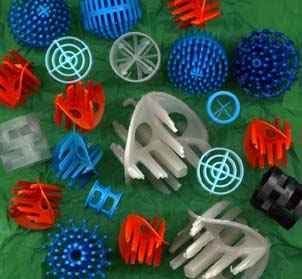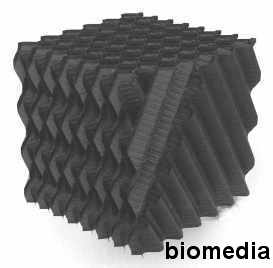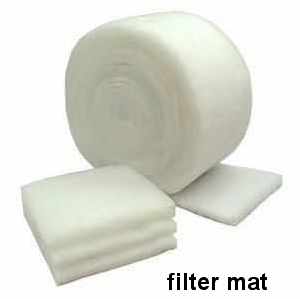

Also a particular container being used for a biological filter may better lend itself to plastic filter media. For example: I used an 300 gallon plastic agriculture water tank for a filter. This tank is approximately 4 foot diameter and 4 foot tall. The top narrows to a 2 foot round opening with a cover. I have yet to build a filter that eventually I did not need to remove the filter media for some reason. I did not want to fill this tank with heavy rock, I would have to cut the tank apart if I wanted to remove the rock. But the plastic filter media can be removed if needed.
What are the disadvantages?
Cost! The number one disadvantage of plastic filter media is the high cost. Usually this stuff is sold by the "gallon", really! I have seen the cost range from $4.00 to as high as $40.00 a gallon. $12.00 to $25.00 seems to be the average.
Why not use rock?
Most of the time rock is the best solution. I do not believe rock is the best designed filter media. But rock is the cheapest solution. Do not get hung up on the smaller is the better argument. The main disadvantage to rock is the weight.
Case Studies:
Three of the Ventura County Koi Society members are currently using plastic media in their Koi pond filters. In November 1992 they were asked to share their experiences. For comparison, the information is presented here as case studies.
Case #1 - Dan Miller
Dan Miller has been keeping Koi since 1969. Dan has been using plastic filter media since 1985. Dan decided to use plastic filter media because of the information he read in aquarium literature, especially articles concerning saltwater reef filtration technology. The pond that Dan is filtering is 750 gallons with a "very heavy" fish load. Dan is using 7 cu. ft. of plastic filter media. Dan uses a up flow gravel filter with polyester mat on top to supplement the plastic filter media. Dan says his experience using plastic filter media has been "excellent" and "its easy to clean." Dan also likes it because it is light weight, seems more efficient due to ease of "complete" cleaning, and it prevents channeling.
Case #2 - Richard Renshaw
Richard has been keeping Koi since 1979. In 1992, Richard replaced the fiber mat in a filter with plastic filter media. Richard decided to use plastic filter media because of its light weight, ease of cleaning, and he felt it would last forever (unlike the fiber mat he was replacing after 2 years). The pond being filtered by plastic filter media is 2400 gallons and has a "medium" fish load. Richard is using 20 cu. ft. of plastic filter media. In addition, there is a pre-filter with 20 cu. ft. of 1 1/2" - 2" rock. So far Richard has experienced very little problems and there was no change in water quality or clarity when he made the switch in 1992. Richard did pre-establish 25% of the plastic filter media by placing it in and around existing filter media for 3 months before transferring it to the new filter.
Case #3 - Daniel McFarlin
Daniel completed his first Koi pond in 1991. Daniel decided to use plastic filter
media for the new pond. Daniel liked plastic filter media because it was light
weight (his barrel filters are elevated on a wood platform). In addition he felt
it would be easy to clean and would not channel. Daniel's pond is 2245
gallons with a "medium-light" fish load. Daniel is using 5 cu. ft. of plastic
filter media in three 55 gallon filter tanks and three 55 gallon settling tanks.
The media Daniel is using "floats", but only about 1 inch of the 12 inch thick
layer of media is above the surface of the water. In addition Daniel is using 3
inches of polyester mat in the three filters. Daniel's experience so far has been
"good"; ammonia and nitrite levels are low.
Note: The plastic filter media used by Dan and Daniel is rated at 65 sq. ft. of
surface area per cubic foot of media. The plastic filter media used by Richard is
larger and is rated at 45 sq. ft. of surface area per cubic foot.
In addition,
Richard and Daniel are using foam fractonators as part of their pond filtering
systems.
Where can I buy bulk quantities?
I have seen or heard of several sources. But after several years of trying to track down reliable sources I have found only two sources (see update below) for bulk quantity sales to the koi hobby.
Ed. note: The KoiUSA Buyers Guide list several sources.
Is one design better?
Although a manufacture may argue that their design is better and more efficient, and this is relevant argument and concern in the limited space of a aquarium filter. In a Koi pond filtering situation; I believe price is the priority consideration when selecting plastic filter media. Cost per claimed square foot of surface area is important when you are buying the quantities we need.
![]() Pictured below is some alternate filter media. For avalability check out
Aquatic Eco-Systems, Inc., eBay, or Black Night (for filter brushes only).
Pictured below is some alternate filter media. For avalability check out
Aquatic Eco-Systems, Inc., eBay, or Black Night (for filter brushes only).



Return to Koi Ponds and Filters
Copyright © 1996-2002, Richard Renshaw, Revised June 15, 2002